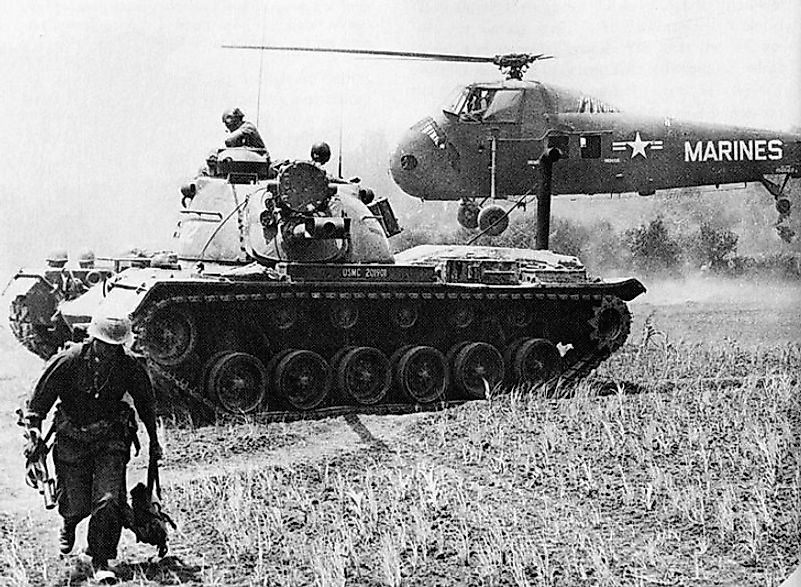The Battle Of Van Tuong - Vietnam War

5. Background
Although the Vietnam War began in 1955, the U.S. and many other United Nations member countries did not become directly involved to a high degree until after 1964. At that time, regime changes in South Vietnam and anti-American actions in North Vietnam prompted increased “Americanization” of the conflict. This battle was one of the first major ones for U.S. forces in the war, and was initially code-named ‘Operation Satellite”. However, a power blackout was encountered during the planning phase, and as a result the transcriber incorrectly labeled the battle name as “Starlite”. Over a period of 6 days (August 18th-August 24th, 1965) the Third Battalion and the Third Infantry of the Third MAF led a large scale campaign of search and destroy against the Northern Vietnamese force of the National Liberation Front. Operation Starlight took place at Van Tuong, which was located at Chu Lai in what was then the nation of South Vietnam, at the I Corps Tactical Zone.
4. Makeup
The vastly outnumbered opposition of the U.S. totaled 1,500 infantry and artillery men. They belonged to the Viet Cong, an army formed within U.S. allies’ borders in South Vietnam and Cambodia, I support of the North Vietnamese People’s Army of Vietnam. The United States Marine Corps’ force involved in the battle were between 5,000- and 6,000-men strong, and were led by General Lew Walt and Major General Oscar Peatross. The U.S. forces were regular Infantry Marines with adept amphibious capabilities, and both of the two top U.S. commanders in the battle had previously served in World War II and the Korean War. The U.S. Marines had ground artillery, helicopter, and naval gun support, while the Viet Cong infantry were backed by mortars, and were known for their guerrilla tactics.
3. Description
On March 8th, 1965, the U.S Marine Corps landed at Da Nang. The first priority was for the Marine Corps to take up a defensive approach against the enemy while in the I Corps Tactical Zone. The adopted military approach was highly successful during the first three months however this plan later changed to offensive one as the Third MAF came to have knowledge that the Vietnamese NLF battalion was moving its forces just to south of Chu Lai.
On August 15th , General Westmoreland, who was the commander of the Military Assistance Command in Vietnam, ordered Major General Walt, the commander of Third MAF, to launch an offensive against the First NLF. General Walt on the other hand was forced to abolish his initial battle plans and made preparations for the planned amphibious assault on 18th August. The First NLF had forces numbering over 1,000 military personnel and this made General Walt request for additional support from the Second Battalion, the Fourth Marine Regiment, ground unit, aerial support and artillery from the U.S Navy.
Operation Starlight was planned to follow two stages. The first move was to surround the First NLF Battalion and move them to a checkpoint which was code-named Phase Line Banana. After reaching the named phase line the Marine Corps were then to reassemble as one unit and force the NLF battalion out of Van Tuong into an open coast where they would be eliminated by the American firepower. On August 18th, the Third Battalion and the Third Marine Division roared to the south of Van Tuong at An Cuong.
The Fourth Marine Regiment established landing zones at the Red, White, and Blue Zones of Van Tuong and, because of this, the American forces were better placed to make advancements towards the Phase Line Banana. An Cuong had little enemy resistance, and the Marines were able to quickly secure the area. Close to the Phase Line Banana, the Fourth Regiment was able to put up a firm resistance from the NLF battalion who were entrenched and also highly disciplined. The Fourth Regiment Soldiers who were stationed at the Blue Landing zone in Nam Yen village on the other hand struggled as they fought against the bunkers which were heavily fortified. After many hours of fighting the enemy lines were broken and on August 19th the American forces reassembled themselves at Phase Line Banana.
2. Outcome
According to U.S. reports, more than 600 Viet Cong were killed, while more than 40 of their soldiers and an assortment of their weapons were captured. On the American side, 51 soldiers were killed, and more than 200 were wounded. As would be the case in many battles in the Vietnam War to come, both sides claimed victory.
1. Significance
This assault by the United States Marine Amphibious Force (MAF) was considered an important one, as this move would cause a massive shift of the military tactics that were to be employed by the MAF moving forward. The new strategy focused on defense, and all the Marine Corps were ordered to protect all important local military interests, in addition to providing security to the people of the South Vietnamese hamlets. One of the Viet Cong’s most frustrating tactics to the U.S. in this battle and the rest of the war involved their use of an intricate system of bunkers and caves. Instead of performing traditional retreats, their troops would instead climb into these underground “nests”, which proved deadly to many of the U.S., South Vietnamese, and other U.N. soldiers who tried to flush them out. Logistically, the battle motivated U.S. leaders to increase water rations for soldiers in battle in the region, and to look for an alternative to the M14 Rifle, which proved cumbersome and impractical amidst the jungle conditions. It also reinforced the need for helicopter support in battles in Vietnam.











